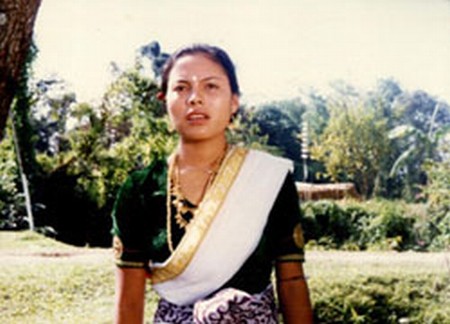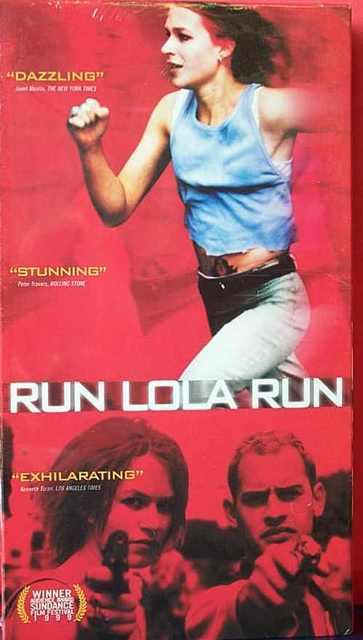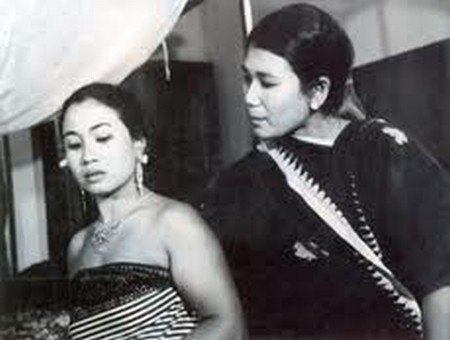Film 'Yengsi' - a qualitative look at Manipuri films/videos in brief
Sanadkumar Aribam *

A scene from Ishanou
"... ... ... ... cinematic beauty can only be expressed in a film, and it must be present in a film for that film to be a moving work,... ... ... ... and that it is the hope of attaining this quality that inspires the filmmaker to make his film in the first place. ... ... ... ... the essence of the cinema lies on cinematic beauty." - Akira Kurusowa
Most of the films produced nowadays (in Manipur) are either video songs or full length films which can be more or less grouped under the Digital Films category. The subjects of these films range from social issues to family dramas. More recently a few films under the horror/thriller genre have also come up, documentaries and short films are very rare.
New artists and filmmakers are coming out in large numbers. While this is good for our industry we should also ensure that along with the increase in quantity there should be an improvement in quality. If pitted against other film industries there are no doubts that ours is lacking in quality.
When I compare all our forms it is encouraging to see that there has been a lot of improvement especially in "video songs" which our films have yet to achieve. This may be because video songs are more popular and shorter than full length films and so more effort spared for these works, even if we do not forget the fact that everything finally depends on the budget of the production.
Below I have listed down a few areas where I believe, improvement can be achieved -
One main concern I want to address is that in almost all the videos, the production teams responsible seem to neglect some of the basic technical aspects of videos, like -
i) Aspect Ratio, Resolution and file formats - whether to go for a widescreen (16:9) or normal (4:3), a 720 or 480, or even HD or standard, or for that matter simple knowledge like how the h264 codec (.mp4 extension) format can be used to get a file of high resolution but with much lesser file size or the later open source format like matroska (.mkv extension).
ii) Broadcast Standards - which standard should be used - NTSC or PAL? For media to be published in Asian/European countries and Australia, including India, PAL (Phase Alternating Line) is the accepted standard whereas for America, Japan and some other countries NTSC (National Television Standards Committee) is the standard to be followed.

Charlie Chaplin
Acting
In Film circles it is widely accepted that 'Charlie Chaplin' is the best actor of all times, though Disney's 'Mickey Mouse' is not far behind. The way Chaplin timed his actions and expressions were perfect and he was able to achieve that without any audible dialogues or the extensive special effects that are at our disposal today. No one is able to dethrone him from the pinnacle of 'acting'. If we look at the contemporary scene I would rate 'Jim Carrey' as the better actor of the rest.
Acting is not everyone's cup of tea. Along with a keen sense of observation and timing one needs talent which should be polished with professional training. Aspiring actors can learn a lot by studying these two actors. Almost all manipuri actors have the same style/sense of acting; it is as if they are copying each other.
I believe Olen and Gokul are two actors who try to bring some variety and uniqueness in their performances. We should always keep in mind that all great actors, from Marlon Brando to Leonardo di Caprio to Min-sik Choi ("Oldboy", Korean) to Amitabh Bacchan to Vikram (Tamil), have their own unique styles and signatures which define them. I hope that with better exposure, observation and training many promising actors of promise will come up from this land which is filled with creative people.

Min-sik Choi
Dialogue
"Dialogue should simply be a sound among other sounds, just something that comes out of the mouths of people whose eyes tell the story in visual terms."- Alfred Hitchcock
This part of filmmaking appears quite neglected in our films. Every film should have dialogues and lines which are unique to that film though in our films these often sound repeated.
Punctuation or emotive words like "ado", "ummm", "he he he", "ha ha ha", etc., are aplenty in our films. All these depict the weakness of the writer as he needs the help of these words to fill in the gaps, though sometimes these are indespensable but not always or everywhere.
Story/Subject/Structure
A great film is one which narrates a good story in a pristine and beautiful way. The narrative structure should be followed in a clever way without getting diverted from the main theme of the story. Films of "Akira Kurusowa" like "Seven Samurai" or Satyajit Ray's films can be referred to understand how beautifully the narration is carried out. Plots and sub plots are filled in at the required points without straying away from the theme.

seven samurai
The common structure, the 'Three Act Structure' can be followed in an aesthetic way to achieve masterpieces. For newer styles and techniques French pioneered "Avant Garde" films like "Run Lola Run" (a 1999 German film) can always be studied. A completely different style of filmmaking was seen in "Memento" (by Christopher Nolan in 2000, the film which inspired the popular Indian movie "Ghazini").
Here, the narration was done backwards and two types of imagery were used for narration, a black and white one was shown in chronological order and a colored one in backwards fashion. The point behind all these references is that we too need to work on a variety of subjects, concepts and styles; we should not limit ourselves to family dramas/social films/romance.

Run Lola Run
Let us experiment with more genres and styles and eventually we too can come up with our own techniques. Let us study more documentaries and short films and world cinema to understand where cinema is going now, let us not remake tried and tested formulae, let us come up with a unique style which the world will recognize and appreciate.
A point to note here is that the directorial style of Aribam Syam Sharma in "Imagi Ningthem" was not typical of Indian Cinema and was completely different from the Indian techniques which were prevalent in those times. Though from a technical point of view the camerawork and editing were rough the narration of the story was done in a clear and plain manner which had its own sweet appeal. I believe it was this value of the film which was appreciated the world over.

Imagi Ningthem
Other than these, all other areas need equal importance; areas like Cinematography and Lighting, Editing, Screenplay, Sound/Music, etc., and Character of the story. The story plays around the CHARACTER(s) and it is he who will make the story stand out. All Classics are classics because of the interesting characters who are the protagonist or antagonist of the film.
From "Godfather" to "Sholay" to "Ishanou", it is the character(s) that we try to connect with and in whom we stay absorbed for the whole movie or even still later. Let us not forget this whenever we attempt to write a script for a film. From great characters are borne great films and immortal characters create immortal films.
Let me point out a couple of things about the use of SOUND EFFECTS and SCORE in our digital films. Effects like walking sounds, turning the pages while the character is reading a magazine, phone ringtones and ambient sounds are always added in very high decibels. In most movies around the world nowadays phone ringtones are mostly included as the 'buzz' of the vibration mode and very hardly can we hear a phone ringtone blaring through your speakers.
A certain control over the level of high and low sounds is always desired. It is not appropriate that the background music or sound effects should be so high as to render the actual dialogue inaudible. And while using copyright tracks as a SCORE within a film we should not forget that if we exceed 10 seconds it is deemed illegal; better not to use such tracks at all.
Finally, most important of all, Manipur needs a good Film Policy. The state government should recognize the manipuri film industry and like other states a Film Policy should be implemented at the earliest possible time so that our film makers enjoy all the subsidies and support such a policy will offer. Let us all work towards this and strive for it.
And regarding the SUBJECT of a film, let us always remind ourselves that by researching deeper into our cultural roots we will be able to come up with unique and independent concepts and characters which will be different from the rest and which will be excellent creative outputs. It is easy to understand that we will not be able to come up with a unique and new English or American or Bollywood story and there is already a high level of competition in these categories. But we can surely come up with a great Manipuri story and that will definitely be a unique story for the rest of the world. As our well respected (late) M.K.Binodini once said fittingly,
"My cultural root is the strength to my literature."
[These are mere brief arguments that I've only managed to mention as it will be too lengthy a matter if I were to write about all these points in detail. I've dealt on both cinema and digital films and tried to bring out the arguments. Please feel free to comment, all types of feedback are more than welcomed. Thank you.]
